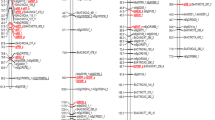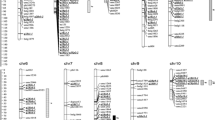Abstract
Oil content and grain yield in maize are negatively correlated, and so far the development of high-oil high-yielding hybrids has not been accomplished. Then a fully understand of the inheritance of the kernel oil content is necessary to implement a breeding program to improve both traits simultaneously. Conventional and molecular marker analyses of the design III were carried out from a reference population developed from two tropical inbred lines divergent for kernel oil content. The results showed that additive variance was quite larger than the dominance variance, and the heritability coefficient was very high. Sixteen QTL were mapped, they were not evenly distributed along the chromosomes, and accounted for 30.91% of the genetic variance. The average level of dominance computed from both conventional and QTL analysis was partial dominance. The overall results indicated that the additive effects were more important than the dominance effects, the latter were not unidirectional and then heterosis could not be exploited in crosses. Most of the favorable alleles of the QTL were in the high-oil parental inbred, which could be transferred to other inbreds via marker-assisted backcross selection. Our results coupled with reported information indicated that the development of high-oil hybrids with acceptable yields could be accomplished by using marker-assisted selection involving oil content, grain yield and its components. Finally, to exploit the xenia effect to increase even more the oil content, these hybrids should be used in the Top Cross™ procedure.
Similar content being viewed by others
References
Berke TG, Rocheford TR (1995) Quantitative trait loci for flowering, plant and ear height, and kernel traits in maize. Crop Sci 35:1542–1549
Berquist RR, Nubel DS, Thompson DL (1998) Production method for corn with enhanced quality grain traits. Patent-USA-5706603
Burdick RK, Graybill FA (1992) Confidence intervals on variance components. M. Dekker Inc., New York
Comstock RE, Robinson HF (1952) Estimation of average dominance genes. In: Gowen JW (ed) Heterosis. Iowa State College Press, Ames, pp 494–516
Dudley JW, Lambert RJ (2004) 100 generations of selection for oil and protein in corn. In: Janick J (ed) Plant breeding reviews: long-term selection-Maize, vol 24 (1). Wiley, Oxford, pp 79–110
Dudley JW, Clark D, Rocheford TR, LeDeaux JR (2007) Genetic analysis of corn kernel chemical composition in the random mated 7 generation of the cross of generations 70 of IHP × ILP. Crop Sci 47:45–57
Garzón LN, Ligareto GA, Blair MW (2008) Molecular marker-assisted backcrossing of anthracnose resistance into Andean climbing beans. Crop Sci 48:562–570
Goldman IL, Rocheford TR, Dudley JW (1994) Molecular marker associated with maize kernel oil concentration in an Illinois high protein × Illinois low protein cross. Crop Sci 34:908–915
Hallauer AR, Miranda Filho JB (1988) Quantitative genetics in maize breeding, 2nd edn. Iowa State University Press, Ames
Jiang C, Zeng ZB (1995) Multiple trait analysis of genetic mapping for quantitative trait loci. Genetics 140:1111–1127
Kosambi DD (1944) The estimation of map distances from recombination values. Ann Eugenics 12:172–175
Lambert RJ (2001) High-oil corn hybrids. In: Hallauer AR (ed) Specialty corns, 2nd edn. CRC Press, Boca Raton, pp 123–145
Lambert RJ, Alexander DE, Han ZJ (1998) A high oil pollinator enhancement of kernel oil and effects on grain yields of maize hybrids. Agron J 90:211–215
Lambert RJ, Alexander DE, Mejaya IJ (2004) Single kernel selection for increased grain oil in maize synthetics and high-oil hybrid development. In: Janick J (ed) Plant breeding reviews: long-term selection-Maize, vol 24 (1). Wiley, Oxford, pp 153–175
Laurie CC, Chasalow SD, LeDeaux JR, McCarroll R, Bush D, Hauge B, Lai CQ, Clark D, Rocheford TR, Dudley JW (2004) The genetic architecture of response to long-term artificial selection for oil concentration in the maize kernel. Genetics 168:2141–2155
Lima MLA, Souza CL Jr, Bento DAV, Souza AP, Garcia LC (2006) Mapping QTL for grain yield and plant traits in a tropical maize population. Mol Breed 17:227–239
Lincoln SE, Daly MJ, Lander ES (1992) Constructing genetic maps with Mapmaker/Exp. 3.0, 3rd edn. Whitehead Institute for Biometrical Research, MAS
Lorenzana RE, Bernardo R (2009) Accuracy of genotypic value predictions for marker-based selection in biparental plant populations. Theor Appl Genet 120:151–161
Lu H, Romero-Severson J, Bernardo R (2003) Genetic basis of heterosis explored by simple sequence repeat markers in a random-mated maize population. Theor Appl Genet 107:494–502
Mangolin CA, Souza CL Jr, Garcia AAF, Garcia AF, Sibov ST, Souza AP (2004) Mapping QTLs for kernel oil content in a tropical maize population. Euphytica 137:251–259
Melchinger AE, Utz HF, Schon CC (2008) Genetic expectations of quantitative trait loci main and interaction effects obtained with the triple testcross design and their relevance for the analysis of heterosis. Genetics 178:2265–2274
Mittelman A, Miranda Filho JB, Lima GJMM, Hara-Klein C, Tanaka RT (2003) Potential of the ESA23B maize population for protein and oil content improvement. Scientia Agricola 60:319–327
Moreira JUV, Bento DAV, Souza AP, Souza CL Jr (2009) QTL mapping for reaction to Phaeosphaeria leaf spot in a tropical maize population. Theor Appl Genet 119:1361–1369
Neereja CN, Maghirang-Rodriguez R, Pamplona A, Heuer S, Collard BCY, Sptiningsih EM, Vergara G, Sanchez D, Xu K, Ismail AM, Mackill DJ (2007) A marker-assisted backcross approach for developing submergence-tolerant rice cultivars. Theor Appl Genet 115:767–776
Sabadin PK, Souza CL Jr, Souza AP, Garcia AAF (2008) QTL mapping for yield components in a tropical maize population using microsatellite markers. Hereditas 145:194–203
SAS Institute Inc (2001) SAS/STAT User’s guide, v.6.03. SAS Institute, Cary
Sibov ST, Souza CL Jr, Garcia AAF, Silva AR, Mangolin CA, Benchimol LL, Souza AP (2003) Molecular mapping in tropical maize using microsatellite markers. 2. Quantitative trait loci (QTL) for grain yield, ear height, and grain moisture. Hereditas 139:107–115
Silva AR, Souza CL Jr, Aguiar AM, Souza AP (2004) Estimates of genetic variance and level of dominance in a tropical maize population.I. Grain yield and plant traits. Maydica 49:65–71
Song TM, Chen SJ (2004) Long term selection for oil concentration in five maize populations. Maydica 49:9–14
Song XF, Song TM, Daí JR, Rocheford TR, Li JS (2004) QTL mapping of kernel oil concentration with high-oil maize by SSR markers. Maydica 49:41–48
Stuber CW, Sisco P (1992) Marker-facilitated transfer of QTL alleles between inbred lines and responses in hybrids. In: Proceedings of 46th Ann Corn Sorghum Res. Conference. ASTA, Washington pp 104–113
Thomison PR, Geyer AB, Lotz LD, Siegrist HJ, Dobbels TL (2002) TopCross high-oil corn production: agronomic performance. Agron J 94:290–299
Thomison PR, Geyer AB, Lotz LD, Siegrist HJ, Dobbels TL (2003) TopCross high oil corn production: select grain quality attributes. Agron J 95:147–154
Val DL, Schwartz SH, Kerns MR, Deikman J (2009) Development of a high oil trait for maize. In: Kriz AL, Larkins BA (eds) Biotechnology in agriculture and forestry, vol 63: molecular genetic approaches to maize improvement. Springer-Verlag Press, Berlin, pp 303–323
Wang S, Basten CJ, Zeng ZB (2005) Windows QTL Cartographer 2.5. Department of Statistics, North Caroline State University, Raleigh. http://statgen.ncsu.edu/qtlcart/WQTLCart.htm. Accessed March 17, 2010
Wasson JJ, Mikkelineni V, Bohn MO, Rocheford TR (2008a) QTL for fatty acid composition of maize kernel oil in Illinois High Oil × B73 backcross-derived lines. Crop Sci 48:69–78
Wasson JJ, Wong JC, Martinez E, King JJ, DeBaene J, Hotchkiss JR, Mikkilineni V, Bohn MO, Rocheford TR (2008b) QTL associated with maize kernel oil, protein, and starch concentrations; kernel mass; and grain yield in Illinois high oil × B73 backcross-derived lines. Crop Sci 48:243–252
Willmot DB, Dudley JW, Rocheford TR, Bari AL (2006) Effect of random mating on marker QTL associations for grain quality traits in the cross of Illinois high oil × Illinois low oil. Maydica 51:187–199
Yang XH, Guo YQ, Yan JB, Zhang J, Song TM, Rocheford TR, Li JS (2010) Major and minor QTL and epistasis contribute to fatty acid compositions and oil concentration in high-oil maize. Theor Appl Genet 20:665–678
Zhang J, Lu XQ, Song XF, Yan JB, Song TM, Dai JR, Rocheford TR, Li JS (2008) Mapping quantitative trait loci for oil, starch, and protein concentrations in grain with high-oil maize by SSR markers. Euphytica 162:335–344
Acknowledgements
This research was supported by Conselho Nacional de Desenvolvimento Científico e Tecnológico (CNPq-308499/2006-9), and by Department of Genetics at the Agriculture College “Luiz de Queiroz”/University of São Paulo. C. L. Souza Jr. is recipient of a research fellowship from CNPq. Authors are grateful to Dr. Anete Pereira de Souza, from the University of Campinas, for the genetic mapping of the population; to Dr. Luis Alberto Colnago, from Embrapa/Instrumentação, for the analysis of the kernel oil content; and to A. J. Desidério, A. S. Oliveira, A. O. Gil, C. R. Segatelli, and A. Silva for their assistance with the field experiments. We are also grateful to three anonymous reviewers for their constructive suggestions.
Author information
Authors and Affiliations
Corresponding author
Rights and permissions
About this article
Cite this article
Môro, G.V., Santos, M.F., Bento, D.A.V. et al. Genetic analysis of kernel oil content in tropical maize with design III and QTL mapping. Euphytica 185, 419–428 (2012). https://doi.org/10.1007/s10681-011-0604-x
Received:
Accepted:
Published:
Issue Date:
DOI: https://doi.org/10.1007/s10681-011-0604-x




